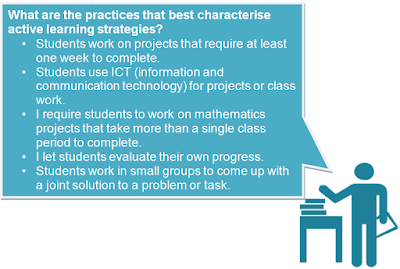Head of the Innovation and Measuring Progress Division, Directorate for Education and Skills
The new Education Indicators in Focus brief, based on the most recent data published in indicator B7 of Education at a Glance 2016, deepens the analysis on the factors influencing the per-student salary cost of teachers. Each country’s per-student salary cost is based on a mix of four main factors: teachers’ salaries, teaching time, instruction time and class size. The figure above shows the weight of each of these four factors, compared to the OECD average, in each country’s per-student cost of teachers. The differences between countries are striking, especially between countries that arrive at a similar per-student salary cost of teachers, but based on a very different mix of the four components mentioned.
Take, for example, two countries with a similarly high per-student cost of teachers, the Flemish Community of Belgium and Germany. In the former, the per-student salary cost is relatively high, because all four components are more cost-intensive than the OECD average, adding up to a high total salary cost even if the teachers’ salaries are not very high. In Germany, teachers’ salaries are much higher, but their impact on the per-student salary cost is offset by more-than-average teaching time and lower-than-average instruction time.
At the other end of the spectrum are the Czech Republic and Turkey, countries with a relatively low per-student salary cost of teachers. In the former, instruction time, teaching time and class size are close to the OECD average, but the per-student salary cost is driven downwards by much lower teachers’ salaries (in real terms). In Turkey, teachers are better paid than their Czech colleagues, but the per-student cost is offset by less instruction time and larger classes.
Is there, then, a particular mix of components that makes an education system more effective? Apart from Korea, most high-performing countries in PISA are found towards the left of the chart, indicating a relatively higher-than-average per-student salary cost of teachers. But even those high-performing countries do not share a common mix of components – except, perhaps teachers’ salaries. In all high-performing countries except Finland, teachers’ salaries are higher than the OECD average.
The impact of other factors – including class size – is much less clear. Education at a Glance 2016 shows that many countries have reduced average class size over the past decade or so, responding to political pressure and public demand. But the evidence on the impact of smaller classes on the effectiveness and quality of teaching and learning is patchy. Analysis of PISA data reveals that there might be some positive impact from reducing class size, but much less than if teachers’ salaries were raised or if more were invested in teachers’ professionalism, instead. Some academic research evaluates the effect of smaller classes more positively, but this research is mostly limited to North America and Europe, whereas large classes are the norm in high-performing systems in Asia.
The factor of instruction time has a similarly uneven impact on performance. Some high-performing systems, as measured by PISA, such as Finland, require less instruction time than on average across OECD countries, thus offsetting the cost of higher teachers’ salaries. But other countries, such as the Netherlands, show above-average instruction time, contributing to a relatively higher per-student salary cost. The Education Indicators in Focus brief n° 22 looked into the issue of instruction time in more detail, but did not find any conclusive evidence on the relationship between instruction time and the quality of learning.
In times when governments need to contain the cost of education, improve the quality of teaching and learning, and increase the efficiency of spending, the cost of the teaching force is a major area of concern. The evidence shows that there is no magic formula for mixing the components of the per-student salary cost, but it does suggest that prioritising teachers’ salaries over class size and instruction time makes sense. Lowering teacher salaries might be the easiest way to cut costs – and the evidence suggests that countries have done this in the recent past in response to the financial crisis – but a more sophisticated look into all the factors influencing the cost of education might be more appropriate.
Links:
Education Indicators in Focus No. 46: What influences spending on education? by Camila de Moraes
Education at a Glance 2016: OECD Indicators
Programme for International Student Assessment (PISA)
Chart source: OECD (2016), Education at a Glance 2016: OECD Indicators, www.oecd.org/education/education-at-a-glance-19991487.htm.





